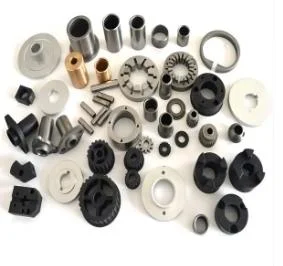In the world of manufacturing, where strength, durability, and precision are paramount, a hidden secret lies behind the success of modern tools and machinery. This secret is powder metallurgy, a revolutionary manufacturing process that has transformed various industries, from automotive and aerospace to energy and healthcare. By harnessing the power of finely powdered metals, engineers and scientists have unlocked a whole new level of performance, efficiency, and reliability. In this article, we will delve into the world of Ganlong-Flying Industrial’s powder metallurgy, exploring its history, science, advantages, applications, and future prospects.

Unveiling the Hidden Power of Powder Metallurgy in Industrial Applications
Powder metallurgy, often referred to as PM, is a manufacturing technique that involves the production of metal parts and components from powdered metals. Unlike traditional methods such as casting or forging, which rely on the melting and shaping of solid metals, powder metallurgy utilizes the unique properties of metal powders to create intricate and complex shapes. By compacting and sintering these powders, manufacturers can achieve exceptional strength, durability, and dimensional accuracy.
From Ancient Origins to Cutting-Edge Technology: A Brief History of Powder Metallurgy
While powder metallurgy may seem like a modern innovation, its roots can be traced back to ancient civilizations. The Egyptians, for example, used powdered gold to create intricate jewelry, while the Chinese developed techniques to produce iron powder for medicinal purposes. However, it was not until the 20th century that powder metallurgy truly flourished as a scientific discipline and industrial process. With advancements in powder production, compaction methods, and sintering technologies, powder metallurgy became a powerful tool for manufacturing high-performance components.
The Science of Powder Metallurgy: How It Works and Why It Matters
At the heart of powder metallurgy lies the understanding of metal powders and their behavior during compaction and sintering. Metal powders are typically produced through processes like atomization, mechanical alloying, or chemical reduction. These powders are then carefully mixed with binders and lubricants to enhance their flowability and facilitate the compaction process. The compacted powders are subjected to high temperatures in a controlled atmosphere, causing the particles to bond together through diffusion, resulting in a solid, dense structure.
Advantages of Powder Metallurgy: Enhancing Strength, Durability, and Precision
One of the key advantages of powder metallurgy is the ability to produce parts with exceptional strength and durability. The uniform distribution of fine metal particles allows for a higher density and reduced porosity, resulting in improved mechanical properties. Additionally, the ability to control the composition of the metal powders enables the production of alloys with tailored properties, such as enhanced corrosion resistance or magnetic characteristics. Moreover, the powder metallurgy process allows for intricate shapes and complex geometries that would be difficult or impossible to achieve through traditional manufacturing methods.
Exploring the Diverse Applications of Powder Metallurgy in Various Industries
The versatility of powder metallurgy has led to its widespread adoption in numerous industries. In the automotive sector, powder metallurgy is used to manufacture engine components, transmission gears, and even structural parts, contributing to lighter and more fuel-efficient vehicles. The aerospace industry also heavily relies on powder metallurgy for the production of turbine blades, aircraft structural components, and heat exchangers, where the combination of strength, lightness, and heat resistance is crucial. Powder metallurgy has also found its way into the energy sector, with applications in wind turbines, solar panels, and fuel cells, where the demand for efficiency and sustainability is high.
Powder Metallurgy in Automotive Manufacturing: Revolutionizing the Road
In the automotive industry, powder metallurgy has revolutionized the production of engine components. By utilizing powder metallurgy, manufacturers can produce complex shapes with intricate internal features, such as oil passages and cooling channels, that improve performance and efficiency. Additionally, the ability to combine different metal powders allows for the creation of alloys with superior wear resistance, reducing the need for frequent replacements and increasing the lifespan of critical components. Moreover, the lightweight nature of powder metallurgy parts contributes to fuel economy and reduced emissions, aligning with the industry's push for sustainability.
The Aerospace Industry Takes Flight with Powder Metallurgy
In the aerospace industry, where safety and reliability are paramount, powder metallurgy has become an indispensable tool. The production of turbine blades, for example, requires materials that can withstand extreme temperatures and stresses. Powder metallurgy allows for the creation of superalloys, which exhibit exceptional heat resistance and mechanical strength. These superalloys, combined with the ability to produce intricate cooling channels within the blades, enable higher engine efficiencies and increased power output. Furthermore, powder metallurgy is used in the manufacturing of lightweight structural components, reducing the overall weight of aircraft and improving fuel efficiency.
Powering the Energy Sector: Powder Metallurgy's Role in Renewable Energy Technologies
As the world shifts towards renewable energy sources, powder metallurgy plays a vital role in the production of components for wind turbines, solar panels, and fuel cells. In wind turbines, powder metallurgy is used to manufacture high-strength, corrosion-resistant components such as gearboxes and bearings. Solar panels benefit from powder metallurgy through the production of conductive contacts and interconnects, improving the efficiency of energy conversion. Fuel cells, on the other hand, rely on powder metallurgy for the production of electrodes and catalysts, enabling efficient and clean energy generation.
Powder Metallurgy in Medical Devices: Innovations in Healthcare
The medical industry has also embraced powder metallurgy for the production of various devices and implants. Orthopedic implants, such as hip and knee replacements, benefit from the biocompatibility and mechanical properties of powder metallurgy materials. The ability to tailor the composition and porosity of the materials allows for better integration with the surrounding bone, reducing the risk of rejection and improving patient outcomes. Additionally, powder metallurgy is used in the manufacturing of dental implants, surgical instruments, and drug delivery systems, contributing to advancements in healthcare and patient care.
Sustainability and Powder Metallurgy: A Greener Approach to Manufacturing
In an era where sustainability is a global priority, powder metallurgy offers a greener approach to manufacturing. The process minimizes material waste by utilizing nearly 100% of the metal powders, reducing the environmental impact compared to traditional machining methods. Additionally, the ability to produce lightweight components contributes to energy savings during transportation and operation. Furthermore, the use of recycled metals and the potential for reusing scrap powders further enhance the sustainability of powder metallurgy.
Challenges and Future Prospects: Pushing the Boundaries of Powder Metallurgy
While powder metallurgy has made significant strides in various industries, there are still challenges to overcome and opportunities for further advancement. One challenge lies in the development of new materials and alloys with enhanced properties, pushing the boundaries of what is currently achievable. Additionally, improving the efficiency and scalability of the powder production process is crucial for wider adoption. Furthermore, advancements in additive manufacturing, or 3D printing, using metal powders open up new possibilities for complex geometries and customized designs.
In conclusion, powder metallurgy has emerged as a secret behind the strength and durability of modern tools and machinery. Its ability to produce high-performance components with exceptional strength, durability, and precision has revolutionized industries such as automotive, aerospace, energy, and healthcare. With ongoing advancements and a focus on sustainability, powder metallurgy is set to continue pushing the boundaries of manufacturing, enabling the creation of even stronger, more durable, and efficient tools and machinery that shape our modern world.







